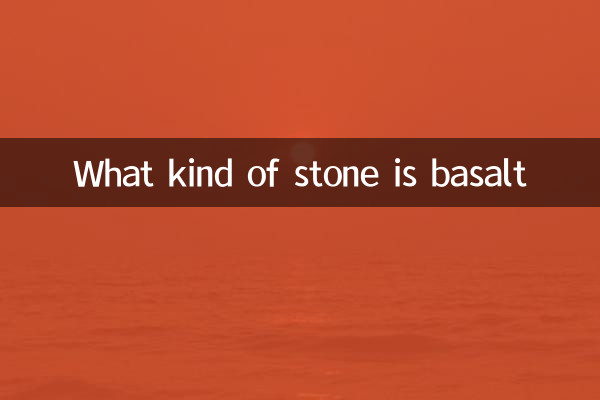What kind of stone is basalt
Basalt is a common volcanic rock consisting mainly of pyroxene and plagioclase, usually in black or dark green colors. It is one of the most widely distributed volcanic rocks on the earth's surface and is widely distributed in mid-ocean ridges, volcanic islands and continental volcanic belts. The formation of basalt is closely related to volcanic eruptions. It has a hard texture and is often used in areas such as construction and road paving. The characteristics, classification and uses of basalt will be described in detail below.
1. Characteristics of basalt

The main mineral components of basalt are pyroxene and plagioclase, and they also contain a small amount of olivine, magnetite, etc. Its chemical composition is ferromagnesium-rich silicate, and the SiO₂ content is usually between 45% and 52%. The density of basalt is relatively high, generally 2.8-3.0 g/cm³, and the hardness is 6-7. Due to its rapid cooling, basalt often exhibits fine-grained or cryptocrystalline structures, and sometimes stomatal structures are visible.
| characteristic | Values/Description |
|---|---|
| Major minerals | Pyroxene, plagioclase |
| color | Black, dark green |
| SiO₂ content | 45%-52% |
| density | 2.8-3.0 g/cm³ |
| hardness | Level 6-7 |
2. Classification of basalt
Basalt can be divided into many types according to its causes and structure. The following are common categories:
| Classification basis | type | feature |
|---|---|---|
| structure | Stomatal basalt | Contains a large number of pores, often filled with calcite or quartz |
| Column jointed basalt | Cooling and shrinking to form a hexagonal columnar structure | |
| Almond-shaped basalt | Stomata are filled with secondary minerals, and are shaped like apricot kernels | |
| Causes | Oceanic basalt | Formed in the mid-ocean ridge, rich in ferromagnesium |
| Continental basalt | Formed in mainland volcanic activity, containing more aluminum |
3. The use of basalt
Basalt is widely used in many fields due to its hard, wear-resistant and corrosion-resistant properties:
| use | Specific application |
|---|---|
| Building materials | Paving roads, making stone slabs, and building decoration |
| Industrial raw materials | Production of basalt fibers and casting sand |
| Garden landscape | Rockery, sculptures, courtyard stone |
| Scientific research | Study the internal structure and volcanic activities of the Earth |
4. Distribution of basalt
Basalt is widely distributed around the world, and the following are some famous basalt distribution sites:
| area | Famous basalt landform |
|---|---|
| Iceland | mid-Atlantic Ridge Basalt Plateau |
| India | Deccan Plateau Basalt |
| China | Changbai Mountain Basalt, Emei Mountain Basalt |
| USA | Columbia River Basalt Group |
5. Research significance of basalt
Basalt is not only an important natural resource, but also has great significance for the study of earth's evolution, plate tectonics and volcanic activities. Through the analysis of basalt, scientists can understand mantle composition, magma evolution process, and paleoenvironmental changes. In addition, minerals and trace elements in basalt also provide important clues for mineral exploration.
In short, basalt is a rock with both practical and scientific research value. Its unique properties and wide application make it an important research object in the fields of geology and materials science.

check the details

check the details